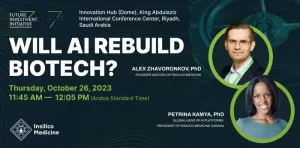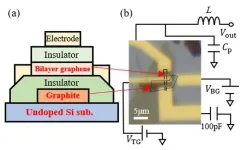(Press-News.org) A new study is gathering extensive data about people with bipolar disorder to improve diagnosis and treatment of this mental health condition that affects 40 million people worldwide, according to the World Health Organization.
UCLA Health is among six inaugural sites of the BD2 Integrated Network, which aims to enroll 4,000 participants for the study. Researchers intend to collect health metrics, brain scans, self-reported symptoms and data on movement and sleep from wearable trackers, over time, in what’s known as a longitudinal cohort study.
The BD2 Integrated Network also forms a learning collective among the research sites, helping scientists, clinicians and people with bipolar disorder learn from each other and analyze data in almost real time to improve clinical care.
“I’m not aware of any other mental health study of this scope,” says Jennifer Kruse, MD, principal investigator of the study at UCLA Health. “We’re collecting huge amounts of information, so that any scientist at any of the sites can bring an aim — a specific scientific question — and answer it with the data that we have available in this large longitudinal cohort.”
What is bipolar disorder?
Bipolar disorder is a mental health condition characterized by episodes of depression and mania that affects a person’s mood, energy and ability to function in everyday life. As many as 70% of people with bipolar disorder are misdiagnosed at least once, according to research.
These episodes can be disruptive and last for weeks to months. During a manic period, a person experiences high energy and a decreased need for sleep. An individual may spend a week feeling restless, speaking rapidly, engaging in more activities than usual and experiencing uncontrollable racing thoughts. Depressive episodes, which are typically longer than manias, can last for months, during which individuals may feel intense sadness or hopelessness, and experience changes in sleep or appetite, along with thoughts of death or suicide.
While some people with bipolar disorder may cycle through these episodes within a few weeks or months, many don’t, Dr. Kruse says. There can also be periods of neutral mood and energy in between, sometimes for long stretches. The goal of treatment is to prevent these episodes, she says.
Treatment for bipolar disorder may include mood-stabilizing medication, such as lithium, but it is not effective for everyone, Dr. Kruse says. Though there are many treatment options available, she says, there are few predictors of response to individual treatment.
“For some patients who have bipolar disorder, we have to choose medications by trial and error to help them get well and stay well,” she says. Dr Kruse added that it often takes multiple different medication trials before patients begin to feel like themselves again.
One goal of the BD2 Integrated Network is to illuminate variations in the condition and personal characteristics that can help predict which treatments might be most effective for each individual. Reaching this goal would help patients spend more time feeling well by empowering them and their doctors to choose treatments that are most likely to help, based upon individual characteristics, Dr. Kruse says.
“It really has the potential to be transformative,” she says.
A comprehensive picture
Study participants will undergo annual brain scans, including structural and functional magnetic resonance imaging (MRI). Each individual’s biology will be studied annually through blood samples that test for hormone levels, genetic makeup, metabolic measures and inflammation. Study participants will also wear digital trackers that passively monitor their sleep, movement, heart rate and other metrics.
The five-year study includes annual visits with a clinician and multiple check-ins throughout the year to inquire about participants’ lives and any changes in sleep and mood. Participants will also complete self-assessment scales at various points during the study.
“It’s a huge data ecosystem that’s being created,” Dr. Kruse says.
This data ecosystem will be available for countless future studies of bipolar disorder. Among the potential studies Dr. Kruse and her colleagues at UCLA Health – including fellow investigators David Miklowitz, PhD; Michael Gitlin, MD; and Katherine Narr, PhD – may undertake include explorations of how mood disorders affect cellular function and the complex relationship between bipolar disorder and obesity.
“It’s just reflective of the many different directions that we have the potential to go in for this study,” Dr. Kruse says. “There’s endless opportunity to delve in and to answer some of these questions.”
Improving care in near-real time
One aspect of the BD2 Integrated Network that’s particularly exciting to Dr. Kruse and other clinicians is its learning health network, with clinicians, patients and researchers sharing information and best practices as they emerge.
“It’s like a quality improvement approach — seeing things and then implementing changes based on what we’re seeing, but on a large scale, across institutions,” Dr. Kruse says. “It’s this community of clinicians and researchers collaborating with patients and trying to analyze data in as close to real time as possible, then implementing changes based on that data, similar to what has been done successfully with other disorders,” such as pediatric inflammatory bowel disease and pediatric cases of COVID-19.
The process of collecting and analyzing research data, disseminating the knowledge gained and translating findings into clinical practice typically takes many years. However, a learning health network aims to expedite this process and quickly transform data into actionable insights that improve patient care, says Dr. Kruse.
UCLA Health will first recruit participants for the new study from patient populations already being treated for bipolar disorder at its clinics, Dr. Kruse says.
“It’s an incredible opportunity for us to help our patients get well faster and to stay well,” she says. “I’m over the moon that we’re part of this and can help contribute to the improvement of people's lives over time.”
END
UCLA Health part of new study digging into the unknowns of bipolar disorder
'It really has the potential to be transformative,’ says UCLA Health psychiatrist Jennifer Kruse
2023-10-20
ELSE PRESS RELEASES FROM THIS DATE:
Insilico Medicine presents at Future Investment Initiative Conference in Riyadh
2023-10-20
Executives from clinical stage artificial intelligence (AI)-driven drug discovery company Insilico Medicine will present on the impact of AI on biotechnology at the Future Investment Initiative (FII) Conference in Riyadh, Saudi Arabia.
Alex Zhavoronkov, PhD, founder and CEO of Insilico Medicine and Petrina Kamya, PhD, Head of AI Platforms and President of Insilico Medicine Canada will present on the topic “Will AI Rebuild Biotech?” on Oct. 26, 11:45am Arabic Standard Time. The event is available to be livestreamed.
The FII Conference brings together the world’s foremost CEOs, policymakers, ...
Study shows promise for iNKT cell platform to treat cancer
2023-10-20
Allogeneic invariant natural killer T cells (allo-iNKTs) from a healthy donor have been shown to have therapeutic effects in treatment-resistant cancers and improve survival from COVID-19-related acute respiratory failure in previous studies. Unlike T cells, allo-iNKTs can be transferred from one person to another without causing graft-versus-host disease. But allo-iNKT cells rapidly become undetectable in the body after infusion, raising concerns over their rejection and disease relapse. Their functioning also varies from person to person.
Researchers from the School of Veterinary Medicine and Perelman School of Medicine hypothesized ...
Moving muscle fibers with magnets “programs” how they align within tissue
2023-10-20
Stimulating muscle fibers with magnets causes them to grow in the same direction, aligning muscle cells within tissue, Massachusetts Institute of Technology (MIT) and Boston University investigators report October 20 in the journal Device. The findings offer a simpler, less time-consuming way for medical researchers to program muscle cell alignment, which is strongly tied to healthy muscle function.
“The ability to make aligned muscle in a lab setting means that we can develop model tissues for understanding muscle in healthy and diseased states and for developing and testing new therapies ...
How cord-like aggregates of bacteria lead to tuberculosis infections
2023-10-20
The ability of Mycobacterium tuberculosis (MTB), a serious respiratory infection, to form snake-like cords was first noted nearly 80 years ago. In a study published October 20 in the journal Cell, investigators report the biophysical mechanisms by which these cords form and demonstrate how several generations of dividing bacteria hang together to create these structures that enable resistance to antibiotics.
“Our work clearly showed that cord formation is important for infection and why this highly ordered architecture might be important for pathogenesis,” says senior author Vivek Thacker (@DrVivekThacker), who ...
Wobbly gel mat trains muscle cells to work together
2023-10-20
There’s no doubt that exercise does a body good, including strengthening and toning our muscles. But how exactly does exercise make this happen?
As we run and lift and stretch, our muscles experience chemical signals from surrounding cells, as well as mechanical forces from jostling against tissues. Some physiologists wonder: Is it the body’s natural chemical stimulants or the physical forces of repeated motion — or some mix of the two — that ultimately drive our muscles to grow? The answer could be the key to identifying therapies to help people recover from muscle ...
Specialty palliative care and symptom severity and control in adolescents and young adults with cancer
2023-10-20
About The Study: In this study of 5,435 adolescents and young adults with cancer, those reporting moderate or severe symptoms through a screening program were more likely to subsequently receive specialty palliative care. These findings suggest that specialty palliative care was associated with a subsequent decrease in pain severity but did not affect other symptoms. New interventions targeting other symptoms during treatment and particularly at the end of life are needed.
Authors: Sumit Gupta, M.D., Ph.D., of the Hospital for Sick Children in Toronto, is the corresponding author.
To access the embargoed study: ...
Noninvasive bioelectronic treatment of postcesarean pain
2023-10-20
About The Study: In this randomized clinical trial of 134 individuals who underwent a cesarean delivery, use of a high-frequency electrical stimulation device as part of a multimodal analgesia protocol decreased opioid use in the immediate postoperative period and opioids prescribed at discharge. These findings suggest that the use of this device may be a helpful adjunct to decrease opioid use without compromising pain control after cesarean delivery.
Authors: Jennifer L. Grasch, M.D., of the Ohio State University Wexner Medical Center in Columbus, is the corresponding author.
To ...
Does suspending kids from school harm their grades and health?
2023-10-20
Being suspended from school or sent to the office is tied to a big drop in grade point average (GPA), especially for Black and Latinx children, according to UC San Francisco researchers.
Their study, publishing Oct. 20, 2023, in JAMA Network Open, analyzed the school records of 16,849 students in grades 6 through 10 in a large urban school district in California from 2014 to 2017. Black students who had an “exclusionary school discipline” (ESD) event – being removed from a classroom or suspended ...
What do new moms and roaches have in common?
2023-10-20
Researchers are studying the dramatic physical transformation that some insects undergo to give birth to live young.
This includes suppressing their immune systems to accommodate babies, which is something some insects and people have in common. Understanding how these systems work can help improve treatments for fibromyalgia and other immune disorders.
Biologists at the University of Cincinnati were part of an international team examining the complex structural and physiological changes that take place in Hawaii’s beetle-mimic cockroaches, which give birth to live young.
“It’s ...
Researchers demonstrate a high-speed electrical readout method for graphene nanodevices
2023-10-20
The 'wonder material' graphene is well-known for its high electrical conductivity, mechanical strength, and flexibility. Stacking two layers of graphene with atomic layer thickness produces bilayer graphene, which possesses excellent electrical, mechanical, and optical properties. As such, bilayer graphene has attracted significant attention and is being utilized in a host of next-generation devices, including quantum computers.
But complicating their application in quantum computing comes in the form of gaining accurate measurements of the quantum bit states. Most research has primarily used low-frequency electronics to overcome this. However, ...
LAST 30 PRESS RELEASES:
Longest observation of an active solar region
Why nail-biting, procrastination and other self-sabotaging behaviors are rooted in survival instincts
Regional variations in mechanical properties of porcine leptomeninges
Artificial empathy in therapy and healthcare: advancements in interpersonal interaction technologies
Why some brains switch gears more efficiently than others
UVA’s Jundong Li wins ICDM’S 2025 Tao Li Award for data mining, machine learning
UVA’s low-power, high-performance computer power player Mircea Stan earns National Academy of Inventors fellowship
Not playing by the rules: USU researcher explores filamentous algae dynamics in rivers
Do our body clocks influence our risk of dementia?
Anthropologists offer new evidence of bipedalism in long-debated fossil discovery
Safer receipt paper from wood
Dosage-sensitive genes suggest no whole-genome duplications in ancestral angiosperm
First ancient human herpesvirus genomes document their deep history with humans
Why Some Bacteria Survive Antibiotics and How to Stop Them - New study reveals that bacteria can survive antibiotic treatment through two fundamentally different “shutdown modes”
UCLA study links scar healing to dangerous placenta condition
CHANGE-seq-BE finds off-target changes in the genome from base editors
The Journal of Nuclear Medicine Ahead-of-Print Tip Sheet: January 2, 2026
Delayed or absent first dose of measles, mumps, and rubella vaccination
Trends in US preterm birth rates by household income and race and ethnicity
Study identifies potential biomarker linked to progression and brain inflammation in multiple sclerosis
Many mothers in Norway do not show up for postnatal check-ups
Researchers want to find out why quick clay is so unstable
Superradiant spins show teamwork at the quantum scale
Cleveland Clinic Research links tumor bacteria to immunotherapy resistance in head and neck cancer
First Editorial of 2026: Resisting AI slop
Joint ground- and space-based observations reveal Saturn-mass rogue planet
Inheritable genetic variant offers protection against blood cancer risk and progression
Pigs settled Pacific islands alongside early human voyagers
A Coral reef’s daily pulse reshapes microbes in surrounding waters
EAST Tokamak experiments exceed plasma density limit, offering new approach to fusion ignition
[Press-News.org] UCLA Health part of new study digging into the unknowns of bipolar disorder'It really has the potential to be transformative,’ says UCLA Health psychiatrist Jennifer Kruse


